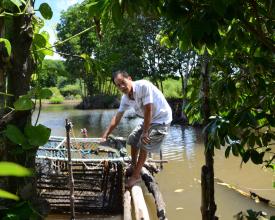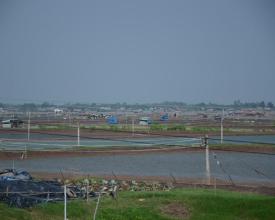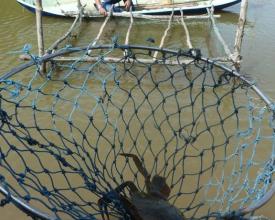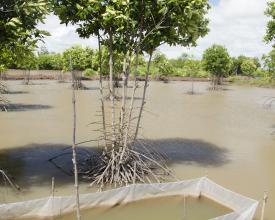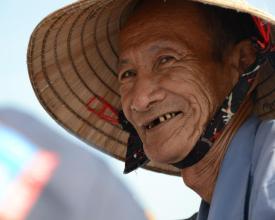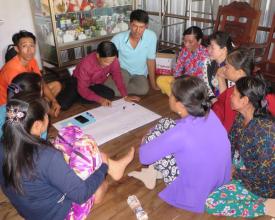
Best Management Practices for Silvo-Aquaculture
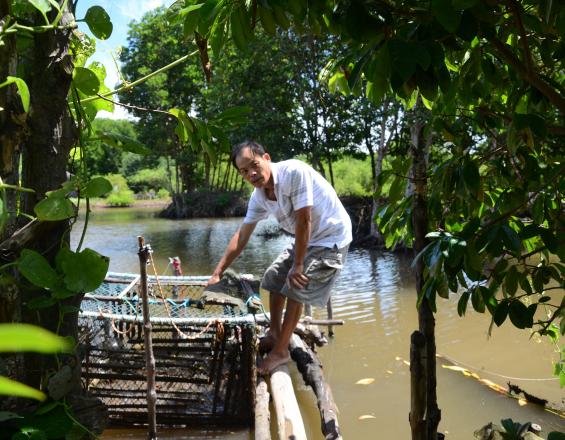
By promoting Best Management Practices for silvo (mangrove) aquaculture, as well as supporting Farmer Interest Groups along the Mekong Delta coast, the solution aims to raise awareness of mangrove ecosystem conservation benefits and diversify farmers’ incomes. It encourages ecological farming techniques and the integration of mangroves in shrimp ponds.
Context
Challenges addressed
Poor culturing techniques and water management, a lack of capital and mono-cultures make the farms prone to calamities and subsequent loss of profit, while at the same time having a negative impact on the surrounding ecosystems. To supplement their income, farmers therefore often collect natural resources from adjacent mangroves, causing further degradation. Additional challenges are the changing climate and extreme weather events as well as coastal erosion.
Location
Process
Summary of the process
The farmers involved in piloting the Best Management Practices for Silvo Acuaculture farming (building block 1) serve as multipliers and ground breakers. Through the formation of Farmer Interest Groups (building block 2), consisting of aquaculture farmers, a network and exchange platform is created. This in turn facilitates the successful dissemination of the Best Management Practices through trainings (building block 3) and mouth to mouth propaganda as well as revision and further development of the Best Management Practices which are regularly updated (building block 1).
Building Blocks
Development of Best Management Practices
Information on current farm practices are gathered in cooperation with relevant institutions, in particular the province`s aquaculture research station and the private sector. Shortcomings of current techniques as well as areas for improvement are identified. At trial farms, these are addressed through the optimization and adaptation of Best Management Practices. These practices promote income diversification and improved aquaculture farm management through optimized species composition, stock density, water management, nursing and mangrove conservation.
The Best Management Practices are regularly adapted to address arising issues and new challenges as well as respond to market requirements.
Enabling factors
- Existing Silvo-Aquaculture farms and expertise
- Farmers willing to adapt farm management and contribute lessons learned
- Aquaculture research station with extensive technical and local knowledge
Lesson learned
Involvement of the nearby Aquaculture Research Station proved to be of great advantage due to their experience and technical knowledge. Farmers from the community were involved in model trials, which then led to greater interest by other farmers to become involved. At least one year of trials is necessary to develop successful Best Management Practices which are then tested and thereafter regularly updated. .
Farmer Interest Groups
Neighboring farmers meet regularly to share information and best practices on diversified aquaculture production. They buy seedlings as a group to be more cost-efficient, and grant loans to the farmer most in need. The loan is given on a yearly basis with a fixed interest rate and financed by the group’s membership fee.
Enabling factors
- Farmers who are willing to participate
- Staff time for facilitation
Lesson learned
Establishing the first group took extensive time due to farmers’ reluctance to trust facilitated group formation. Presenting proven benefits of Interest Groups and providing incentives for trainings (building block 3) convinced farmers to join. Members of the first Farmer Interest Groups served as example and facilitated the formation of additional groups. Involving farmers who operate mangrove aquaculture ponds outside the buffer zone proved successful for disseminating success stories. This convinced a number of farmers to join Farmer Interest Groups and plant mangroves in their pond, thereby increasing the overall forest cover and pond resilience.
Promotion of Best Management Practices
Members of the Farmer Interest Groups are trained how to implement the Best Management Practices by the extension center. The training is partly theoretical and partly practical, and farmers involved in the development phase open their farm to Farmer Interest Group members so they gather first-hand experience. The extension center promotes Best Management Practices by disseminating information further through the extension officer’s daily advisory service. At the same time experiences and lessons learnt are fed back to the extension center to improve the Best Management Practices.
Enabling factors
- Best Management Practices ready for dissemination
- Existing Farmer Interest Groups to receive and disseminate the information
Lesson learned
Involving farmers who had already implemented the Best Management Practices and including practical experiences at farms increased the participation and information uptake on the trainees` side. The Best Management Practices were not written up by an external expert, but are based on experiences and trials at local farms. This increased the acceptance and willingness of farmers to implement the recommendations.
Impacts
An evaluation conducted in March 2014 found that the Best Management Practices had positive effects on the income diversification and production risk. In 2013, the farmers applying the Best Management Practices earned 320USD per year per hectare more than those who did not. This is explained by increased yield and reduced input cost. This was confirmed by an assessment made in 2017, which found that through the application of the Best Management Practices, the survival rate of shrimp increased by 45%. So far, the solution has had a positive impact on at least 200 farmers and their families.
The initiated Farmer Interest Groups provide active platforms for information exchange and teamwork. The documents and promoted practices spread far beyond the farmers who were directly targeted with the solution. Awareness of the importance of protective mangrove forest ecosystems increased and resource exploitation in the adjoining full protection zone decreased. A number of farmers outside the buffer zone are now also implementing the Best Management Practices and thereby contribute to increased forest cover and resilience. Moreover, some intensive farmers started to operate Silvo-Aquaculture ponds in addition to their industrial ponds. This provides them insurance in case of calamities as Silvo-Aquaculture ponds exhibit a much higher resilience.
Beneficiaries
Small scale aquaculture farmers, silvo-aquaculture farmers and coastal area residents.
Sustainable Development Goals
Story
Shrimp farming in Bac Lieu province in Vietnam developed in the 1980s and is growing rapidly in area and volume. The important role of shrimp aquaculture in the local economy is undeniable: it creates millions of jobs and income for the local population, especially in coastal areas which are difficult to use for agriculture. However, 75% of the shrimp production in the Mekong Delta in general and Bac Lieu in particular is small-scale and occurs under the application of traditional farming practices. These do not take advantage of the existing mangrove forest and are often poorly managed, leading to low efficiency in the production and low profitability or even loss while having a negative impact on the environment.
Mr. Doan Van Ua was one of the first farmers to participate in the development and piloting of the Best Management Practices. Through a series of trainings and workshops he has improved his production skills and income considerably, convincing him of the benefit of the application of the Best Management Practices. Since then he has participated actively in the Farmer Interest Group Doan Ket which he now heads, and convinced other farmers to adapt their farming practices.
Recently the application of improved shrimp post larvae selection and nursing have had a great impact on his production, as Mr. Doan Van Ua points out: "We applied it for the crop in October 2016 and achieved very good results; the survival rate of shrimp was at 80%, 45% higher than the previous crop." And walking along the edge of his shrimp pond which is lined by mangroves Mr. Ua says: "We understand and see that, in the context of a changing climate, these mangrove forests are a 'heavenly treasure', are our livelihoods that we need to preserve, bond and grow sustainably."
